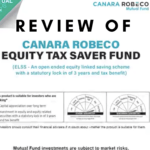How to choose Best Mutual fund
Ben Graham the inventor of the phrase “margin of safety” defined investment as “ An investment operation is one which, upon thorough analysis, promises safety of principle and satisfactory returns. Operations Not meet these requirements are speculative”
Investing can be an exciting journey that allows you to grow your wealth and achieve your financial goals. But before you dive in, it’s essential to equip yourself with a solid understanding of core investment principles. These fundamental concepts provide a roadmap for navigating the financial markets, making informed decisions, and building a successful investment portfolio. Whether you’re a seasoned investor or just starting out, a grasp of these core principles empowers you to take control of your financial future and make smart choices with your hard-earned money
The fundamentals are very easy to grasp and may work as a guiding principle for anybody investing. They do not change for your Mutual fund investing too.
Assigning goals:
Every investment you make should be tied to a specific financial goal. This goal could be as simple as growing your money by a certain percentage over time, or it could be something more substantial like buying a house, funding your children’s education, or securing a comfortable retirement.
Risk :
Understanding your risk tolerance is crucial before investing. Mismatching your risk profile with an investment’s risk level can lead to a negative experience. Imagine a conservative investor placed in a small-cap fund, like the Nippon Small Cap Fund, which experienced a significant downturn of -36.19%. This could cause them considerable anxiety and potentially derail their investment plans.
Conversely, an aggressive investor stuck in an equity-saving fund during a strong market might feel frustrated watching others earn higher returns .

Horizon :
Time horizon in investing refers to the amount of time you plan to hold onto an investment before you need to access the money. It’s a crucial factor in determining your investment strategy and risk tolerance
Common Time Horizons:
Short-Term (0-3 years):
Focuses on preserving capital with minimal risk. Examples include savings accounts, money market funds, and short-term bonds.
Medium-Term (3-10 years):
Aims for a balance between growth and stability. Examples include balanced funds, index funds, and some corporate bonds.
Long-Term (10+ years):
Prioritizes long-term growth with the ability to handle volatility. Examples include growth stock funds, small-cap funds, and real estate investments.
Current asset allocation:
Having your asset allocation analyzed is a critical step in successful investing. This process helps you understand the current makeup of your portfolio and how different assets within it have historically behaved. By analyzing your asset allocation, you can identify any areas where you might be overweight or underweight in certain asset classes. This knowledge empowers you to make informed decisions and potentially adjust your portfolio to better align with your risk tolerance and financial goals( i have written about the concept in my blog https://wealthinn.in/asset-allocation-guideline-for-investment/
Diversification :
Diversification in investing is a fundamental strategy that involves spreading your investments across various asset classes, industries, and even geographical locations. The core principle is to avoid putting all your eggs in one basket. By diversifying, you aim to reduce the overall risk of your portfolio without sacrificing potential returns. Asset allocation tends to take care of your diversification needs
Emergency planning :
Building an emergency fund is a crucial principle of sound financial planning. It’s a safety net that can cover unexpected expenses, such as job loss, medical bills, or car repairs. Aim to save 6-12 months of your living expenses in this fund. This amount can be adjusted based on your circumstances. For example, if you have a steady job and good health insurance, you might target 6 months. Conversely, if you’re self-employed or have high healthcare costs, consider saving closer to 12 months. You can store your emergency fund in a highly liquid account like a Fixed deposit account or a money market fund. Remember to regularly review and adjust your emergency fund as your income and expenses change.
Insurance planning :
Insurance planning is the process of strategically choosing insurance policies to financially protect yourself, your loved ones, and your assets in case of unforeseen events. It’s about identifying potential risks and finding insurance plans that can mitigate the financial burden they might cause. You should at least run one term plan and one health insurance policy apart from your corporate policy if you are salaried .
These profiles prepare you and arm you with necessary steps to investment, i always say that products are last to be selected. Once the profile is clear things are done we can move to look into the products and select the products as per the guidelines given below
Past performance :
Past performance is a tricky concept in investing. While it can provide some insights, it’s not a guaranteed predictor of future results. But we do need to check how the funds are performing as compared to other funds in the category.
Rolling returns :
Rolling returns are a valuable tool for investors looking to understand the historical performance of an investment over various holding periods. Unlike traditional point-to-point returns, which show the change in price from one specific date to another, rolling returns provide a more nuanced picture.
Benefits of Rolling Returns:
Provides a Smoother Picture:
Rolling returns smooth out short-term fluctuations, offering a better understanding of how an investment performs over different holding periods.
Helps Analyze Risk:
By analyzing rolling returns across various holding periods, you can gain insights into the investment’s potential volatility and risk profile.
Informs Investment Decisions:
Understanding how an investment has performed for different holding periods can help you make informed decisions about your own investment horizon and risk tolerance.
Ratios :
Mutual fund ratios are like little keyholes that give you a glimpse into the inner workings of a fund. They offer valuable insights into a fund’s performance, cost structure, and risk profile. Here are some key ratios to understand:
Expense Ratio:
- This is the annual fee a fund charges investors to cover its operating expenses, including management fees and administrative costs. It’s typically expressed as a percentage of the fund’s assets. A lower expense ratio generally translates to higher returns for investors, all else being equal.
Return Ratios:
There are a few key return ratios that shed light on a fund’s historical performance:
Alpha:
Measures how well a fund performs compared to a benchmark index, such as the S&P 500. A positive alpha indicates the fund outperformed the benchmark, while a negative alpha suggests it underperformed.
Beta:
Indicates how volatile a fund is compared to the overall market. A beta of 1 suggests the fund’s volatility mirrors the market. A beta greater than 1 suggests the fund is more volatile than the market, and vice versa for a beta less than 1.
Risk Ratios:
These ratios help you understand the level of risk associated with a fund:
Standard Deviation:
Measures the historical dispersion of a fund’s returns around its average return. A higher standard deviation indicates greater volatility.
Sharpe Ratio:
Combines a fund’s return with its volatility. A higher Sharpe Ratio suggests better risk-adjusted performance, meaning the fund generates a higher return for the level of risk taken.
Benchmark :
The importance of a benchmark in a mutual fund can’t be overstated. It acts as a critical reference point for investors, offering a clear picture of how the fund is performing compared to the broader market or a specific market segment.
Standardized Comparison:
Benchmarks provide a standardized basis for comparing the performance of different mutual funds within the same category. Imagine two large-cap funds – Fund A and Fund B. By comparing their returns to the same benchmark index, like the Nifty 50, you can see which fund has delivered better returns relative to the overall market performance of large-cap stocks.
Identifying Outperformance and Underperformance:
A mutual fund’s performance relative to its benchmark reveals if it’s exceeding or falling short of expectations. If a fund consistently outperforms its benchmark, it suggests the fund manager might be adding value through their stock selection or investment strategy. Conversely, underperformance might necessitate further investigation into the reasons behind the lag.
Fund management team :
The experience and stability of a fund’s management team are important factors to consider. Studies have shown that a long-tenured management team can contribute to a fund’s consistent performance. Frequent changes in fund managers can indicate instability or a lack of strategic direction, which may lead to declining returns. However, it’s important to remember that occasional manager changes can also be positive. A new manager might bring fresh perspectives and strategies that benefit the fund. Therefore, it’s crucial to research the fund manager’s experience, track record, and investment philosophy to assess their fit for the fund’s goals.
Fund strategy or investment style :
Fund strategy and investment style are closely related concepts, but with subtle differences. Here’s a breakdown to help you understand them better:
Fund Strategy:
Broader Overview:
Fund strategy refers to the overall approach a mutual fund takes to achieve its investment objectives. It encompasses a high-level view of the fund’s goals, target asset allocation, and risk tolerance.
Examples:
Some common fund strategies include growth investing (focusing on companies with high growth potential), value investing (focusing on undervalued stocks), income investing (generating regular income through dividends or interest), and index investing (passively tracking a market index).
Investment Style:
Specific Techniques:
Investment style dives deeper into the specific techniques and methodologies used by the fund manager to implement the fund’s strategy. It focuses on factors like:
Market Capitalization:
Large-cap, mid-cap, or small-cap stocks.
Value vs. Growth:
Focus on undervalued stocks or companies with high growth potential.
Quality:
Companies with strong fundamentals and financial health.
Momentum:
Stocks exhibiting strong upward price trends.
Sector Allocation:
Overweighting or underweighting specific industry sectors (e.g., technology, healthcare)
By considering all these factors – asset allocation, time horizon, risk tolerance, diversification, past performance (with caution), expense ratios, fund management, and benchmarks – you’ll be well-equipped to choose suitable mutual funds for your portfolio.






How to use Mutual Funds to meet Financial Planning Goals - Wealthinn.in
January 13, 2025[…] How to choose best of the funds you can refer the blog : How to chose the best mutual fund […]